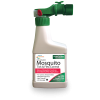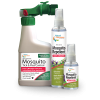There are hundreds of different home remedies for removing ticks and, believe it or not, almost all of them are ineffective and somewhat dangerous.
Removing a tick can be tricky. Ticks have tiny barbs on their mouths which they use to latch onto a host. This helps them stay securely attached while they feed. They also secrete a cement-like substance that acts as an adhesive and makes them difficult to remove.
What's the Best Way to Remove a Tick?
Due to the fact that removing a tick can be such risky business, we wanted to set the record straight and fill you in on the quickest and most effective way to remove these blood-suckers: tweezers!
So wait, after all the articles, tips and tricks on how to remove a tick, the best way is still using tweezers? You bet! The reason being that a lot of tick removal shortcuts require messing with the tick’s abdomen or butt.
Some common and ineffective tick removal tactics we’ve heard about include using petroleum jelly, fire or nail polish on the exposed tick. These methods can cause the tick to push or spit dangerous and disease-ridden fluid into your body. In addition, messing with a tick’s abdomen could puncture or "pop" the tick’s abdomen, exposing the victim, or the person helping, to the dangerous bacteria.
So how can you remove a tick safely?
First, make sure you wear protective gloves and disinfect your tweezers. Next, using the tweezers, gently pinch the portion of the tick closest to the skin (see below), ensuring you do not squeeze the tick’s abdomen.
Slowly pull the tick away from the skin with the tweezers, using equal and constant pressure. Be careful not to twist or turn the tick.
Don’t worry if the tick’s head breaks off and stays latched to the skin, as the dangerous part of the tick (the abdomen) has been removed. The rest should be pushed out by your body over time.
Once removed, freeze the tick in a sealable container in case you get sick and your doctor asks you to identify the tick.
After the tick is safely contained, clean the bite area, taking note of the location of the bite by snapping a picture.
It is important to keep an eye on the area where the bite occurred and seek medical attention if you start to notice any skin discoloration or if you feel sick.
In an effort to help you recognize what the common diseases caused by ticks look like, visit the CDC’s website.
If you’re like most people, you’d prefer to prevent tick bites altogether. Check out these tips on how to prevent tick bites. In addition, a local tick control professional will be able to help you identify trouble spots in your yard and help you develop a prevention plan.
For additional information about controlling ticks in your area, please contact us today.



